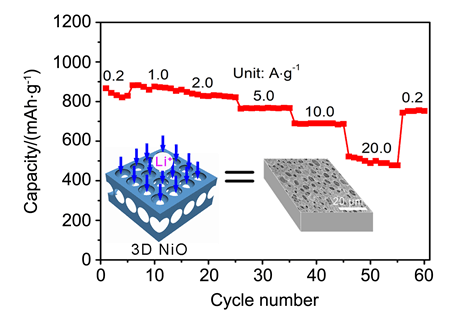摘要/Abstract

三维多孔金属不仅可容纳电极在储锂过程中的体积变化,且为锂离子提供快速传输通道,因此被广泛用做锂离子电池集流体,以提升其循环稳定性和高倍率容量.NiO作为锂离子电池负极具有高理论比容量而备受关注,但其电子导电性差和充放电过程中的巨大体积变化造成其循环寿命短和高倍率容量低.此外,NiO首次放电(嵌锂)产物Ni0和Li2O不能在充电(脱锂)过程中完全反应造成首次不可逆容量大,阻碍了其商业化应用.本工作采用简单、易规模化的化学镀法制备出具有三维贯穿孔的多孔铜(孔径≈5 μm),并在其孔壁电沉积获得NiO@三维多孔铜电极.由于三维多孔铜集流体可容纳NiO储锂过程中的体积变化;为锂离子提供快速传输通道,同时其高比表面积增大了Ni0和Li2O的反应活性点,因此该电极显示出优异的高倍率容量和高首次库伦效率.该电极在200 mA·g-1电流密度下,首次放电(嵌锂)和充电(脱锂)容量分别为1522.3和1230.2 mAh·g-1,首次库伦效率达到80.8%;在高电流密度20 A·g-1下显示578.1 mAh·g-1容量.以NiO@三维多孔铜为负极,LiNi1/3Co1/3Mn1/3O2为正极组装成全电池,首次充电和放电容量分别为1514和1060 mAh·g-1(基于NiO电极,电流密度0.2 A·g-1),首次库伦效率为70%;1.0 A·g-1电流密度下,首次放电比容量为873 mAh·g-1,100次循环后保持709 mAh·g-1,保持率为81%;10 A·g-1电流密度下容量保持530.6 mAh·g-1.该工作将为过渡金属氧化物储锂性能提升提供新途径.
关键词: 锂离子电池, 负极, NiO, 三维多孔, 集流体
Three-dimensional (3D) porous metals have been applied as current collector to improve the cycle stability and high-rate capacities of lithium-ion battery due to they can accommodate volumetric changes of electrodes during lithium storage, and provide rapid transfer channels for lithium ions. NiO has attracted more and more attention due to its high theoretical specific capacity as anode of lithium-ion battery. However its low electrical conductivity and large volumetric changes during electrochemical cycling result in poor cyclability and low high-rate capacity. Besides, the large first irreversible capacity causing from the low reaction activity between the first lithiation products Ni0 and Li2O, hinders its commercial application. In this work, we produce 3D porous Cu with interconnected pores (ca. 5 μm) by a facile and scalable electroless plating method and investigate its role on electrochemical storage improvement for NiO electrode. NiO@3D porous Cu is produced by electrodepositing Ni(OH)2 film coupled with sequential high temperature with 3D porous Cu as the substrate. The NiO film deposited on the 3D porous Cu has mesoporous structure. This unique architecture can provide rapid transfer channels for lithium-ion battery and free place for accommodating volumetric changes of NiO during electrochemical cycling, meanwhile increases reactive points for Ni0 and Li2O. Thus, this electrode demonstrates excellent high-rate capacity and high first columbic efficiency. The first discharge and charge capacities at 200 mA·g-1 are 1522.3 and 1230.2 mAh·g-1 respectively with high columbic efficiency of 80.8%. The same electrode shows high capacity of 578 mAh·g-1 at high current density of 20 A·g-1, which is 48.8% of that at 0.2 A·g-1. The electrochemical impedance spectra (EIS) demonstrate the NiO@3D porous Cu electrode has smaller charge transfer resistance and large Li-ion diffusion efficiency compared with NiO@Cu foil. The SEM images show that the NiO@3D porous Cu electrode suffered 100 cycles remains well 3D porous structure. A full cell is assembled using NiO@3D porous Cu as negative electrode and LiNi1/3Co1/3Mn1/3O2 as positive electrode. The full cell delivers first charge and discharge capacities of 1514 and 1060 mAh·g-1 respectively at 0.2 A·g-1 (based on NiO) with a coulomb efficiency of 70%, a first discharge capacity of 873 mAh·g-1 at 1.0 A·g-1 with 709 mAh·g-1 remained after 100 cycles (the retention is 81%). This work may offer an effective method for lithium storage enhancement of transition metal oxides.
Key words: lithium-ion battery, anode, NiO, three-dimensional porous, current density
PDF全文下载地址:
点我下载PDF
